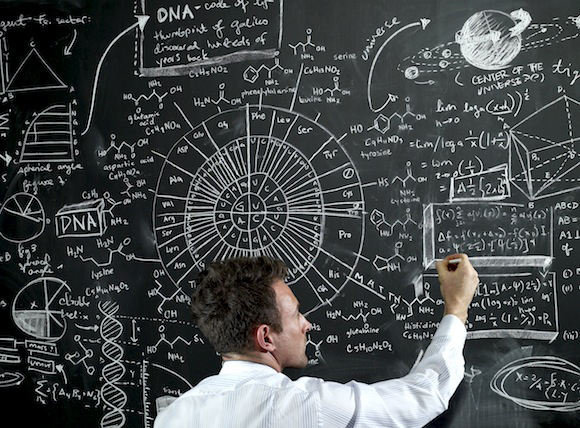Chapter:
What is Theories and Models

Theories and Models
A theory is a set of
systematically interrelated constructs and propositions intended to explain and
predict a phenomenon or behavior of interest, within certain boundary
conditions and assumptions. Essentially, a theory is a systemic collection of
related theoretical propositions. While propositions generally connect two or
three constructs, theories represent a system of multiple
constructs and propositions. Hence, theories can be substantially more complex
and abstract and of a larger scope than propositions or hypotheses.
I must note here that people not familiar with
scientific research often view a theory as a speculation or
the opposite of fact. For instance, people often say that teachers
need to be less theoretical and more practical or factual in their classroom
teaching. However, practice or fact are not opposites of theory, but in a
scientific sense, are essential components needed to test the validity of a
theory. A good scientific theory should be well supported using observed facts
and should also have practical value, while a poorly defined theory tends to be
lacking in these dimensions. Famous organizational research Kurt Lewin once
said, 'Theory without practice is sterile; practice without theory is blind.'
Hence, both theory and facts (or practice) are essential for scientific
research.
Theories provide explanations of social or
natural phenomenon. As emphasized in Chapter 1, these explanations may be good
or poor. Hence, there may be good or poor theories. Chapter 3 describes some
criteria that can be used to evaluate how good a theory really is.
Nevertheless, it is important for researchers to understand that theory is not
'truth,' there is nothing sacrosanct about any theory, and theories should not
be accepted just because they were proposed by someone. In the course of
scientific progress, poorer theories are eventually replaced by better theories
with higher explanatory power. The essential challenge for researchers is to
build better and more comprehensive theories that can explain a target
phenomenon better than prior theories.

A term often used in conjunction with theory
is a model. A model is a representation of all or part of a
system that is constructed to study that system (e.g., how the system works or
what triggers the system). While a theory tries to explain a phenomenon, a
model tries to represent a phenomenon. Models are often used by decision makers
to make important decisions based on a given set of inputs. For instance,
marketing managers may use models to decide how much money to spend on
advertising for different product lines based on parameters such as prior
year's advertising expenses, sales , market growth, and competing products.
Likewise, weather forecasters can use models to predict future weather patterns
based on parameters such as wind speeds, wind direction, temperature, and
humidity. While these models are useful, they may not necessarily explain
advertising expenditure or weather forecasts. Models may be of different kinds,
such as mathematical models, network models, and path models. Models can also
be descriptive, predictive, or normative. Descriptive models are frequently
used for representing complex systems, for visualizing variables and
relationships in such systems. An advertising expenditure model may be a
descriptive model. Predictive models (e.g., a regression model) allow forecast
of future events. Weather forecasting models are predictive models. Normative
models are used to guide our activities along commonly accepted norms or
practices. Models may also be static if it represents the state of a system at
one point in time, or dynamic, if it represents a system's evolution over time.
The process of theory or model development may
involve inductive and deductive reasoning. Recall from Chapter 1 that deduction is
the process of drawing conclusions about a phenomenon
or behavior based on theoretical or logical reasons and an initial set of
premises. As an example, if a certain bank enforces a strict code of ethics for
its employees (Premise 1) and Jamie is an employee at that bank (Premise 2),
then Jamie can be trusted to follow ethical practices (Conclusion). In deduction,
the conclusions must be true if the initial premises and reasons are correct.
In contrast, induction is the
process of drawing conclusions based on facts or observed evidence. For
instance, if a firm spent a lot of money on a promotional campaign (Observation
1), but the sales did not increase (Observation 2), then possibly the promotion
campaign was poorly executed (Conclusion). However, there may be rival
explanations for poor sales, such as economic recession or the emergence of a
competing product or brand or perhaps a supply chain problem. Inductive
conclusions are therefore only a hypothesis, and may be disproven. Deductive
conclusions generally tend to be stronger than inductive conclusions, but a
deductive conclusion based on an incorrect premise is also incorrect.
As shown in Figure 2.3, inductive and
deductive reasoning go hand in hand in theory and model building. Induction
occurs when we observe a fact and ask, 'Why is this happening?'
In answering this question, we advance one or more tentative
explanations (hypotheses). We then use deduction to narrow down the tentative
explanations to the most plausible explanation based on logic and reasonable
premises (based on our understanding of the phenomenon under study).
Researchers must be able to move back and forth between inductive and deductive
reasoning if they are to post extensions or modifications to a given model or
theory, or built better ones, which are the essence of scientific research.
Related Topics